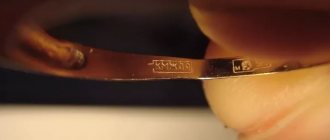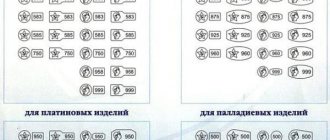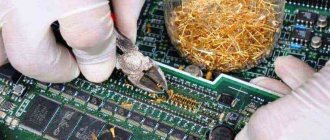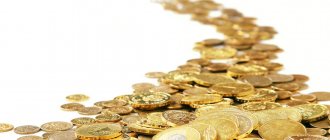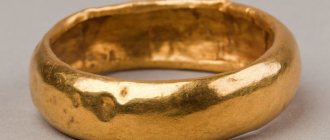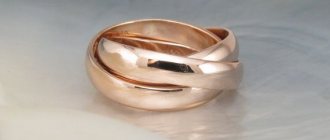Post updated: May 26, 2020
Today, this mineral is of great value in countries all over the world. Any modern girl dreams of being given a piece of jewelry made of gold. This material gained its popularity, value and demand hundreds of years ago. In ancient times, it was a material for the production of dishes, jewelry, clothing and other consumer items. We will consider gold as a metal, and also as one of many elements in the periodic table of chemistry.
Gold (Aurum) is the 79th element of the periodic table.
Today, purchasing an item or jewelry made from this noble metal is not difficult. Many sellers and distributors have a huge range, so there is always a choice.
In this article, anyone can find out the designation of gold in nature, in industry, and also in the periodic table.
- Historical data
- Gold in nature
- Physical properties
- Chemical properties
Gold in history
The first metal that primitive man found was a nugget of gold. This happened back in the Neolithic period, when dishes and other household items began to be made from precious metal. The substance was used in many countries:
- Ancient Egypt;
- India;
- China;
- Roman Empire.
Many literary works contain descriptions of precious metals. Special scientists - alchemists - studied its properties.
They called gold the king of all metals. Believing societies compared it to the sun and believed that the substance was endowed with special magical and healing properties.
The chemical element was mined in large quantities in those places where the first civilizations had sites and dwellings - North Africa, Central Europe, South America. The fossil occurs in nature in the form of nuggets of different sizes. They are found both separately and as part of various substances.
In those days there were no special technologies, so gold was mined by hand. A few grams of pure material could be obtained in only 2-3 days. Extraction specialists carried out work near rivers, where they washed coastal sand using a fine sieve.
As a chemical element on the periodic table, gold is associated with many historical events and geographical discoveries. Man discovered new uninhabited territories and immediately began searching for minerals. If precious grains were embedded in the rock by nature, they were found a few days after settlement. Au is how gold is designated in the periodic table. Its name comes from the Latin language.
Methods of obtaining
Modern technologies make it possible to obtain the noble metal by chemical methods. In 1947, physicists from the United States were able to convert mercury into gold. However, this path requires large expenses, so it has no economic significance.
Popular methods of obtaining the substance:
- Flushing. Since the metal has a high density, it can be produced in a stream of water, which washes away impurities from the material. Pre-mined minerals are crushed and then washed. As a result, what remains is a concentrate, which is gold sand of the heavy fraction. Washing has been used since ancient times for the treatment of small placer deposits. Today, this method uses special washing plants and dredges. During washing, specialists monitor not only small, but also large fragments that may turn out to be nuggets.
- Amalgamation. This method was common in Spain in the 16th century. Then the crushed rock was first moistened, then mixed with mercury and further crushed in mills. After this, an amalgam alloy was obtained, which was washed to obtain gold. Later, crushed material began to be passed through special sluices with copper sheets coated with a thin layer of mercury. This method is used only in deposits with a large volume of precious metal. Today it is popular in Africa and South America.
- Cyanidation. In this method, gold is mixed with cyanide in the presence of oxygen. The resulting crushed material is treated with a solution of sodium cyanide, and then the desired substance is precipitated with zinc dust or ion exchange resins. At first, this method was used in large factories in special vats for crushing mined minerals. But with the development of technology, heap leaching was invented: ore is poured onto a waterproof area and irrigated with cyanide solutions. The dissolved substance enters special columns in which it is deposited.
There is a regeneration method. It is carried out using a 10% alkali solution, which acts on solutions of gold salts and then deposits the metal on aluminum from a hot hydroxide solution. To extract the element from sulfide ores, multi-stage technologies with a high degree of purification are used.
Nature of metal
In nature, the element of Mendeleev's periodic table - gold - is found quite often. According to geographers, 5% of the earth's lithosphere consists of this substance. Even special equipment does not make it possible to simplify the procedure for its extraction, so the cost of the metal is high. Most igneous rocks contain precious material, but it looks like gold dust.
In the earth's crust, matter is deposited due to temperature changes and many chemical processes. The formula of these grains differs from those found on the surface of rocks. Miners find nuggets in iron and mineral ores; in rare cases, gold is present in combination with substances such as:
- antimony;
- selenium;
- bismuth.
The natural element can also be found in the structure of the biosphere. It is found in compounds of living organisms and bacteria.
Small amounts of gold can be extracted even from ordinary running water. At the very beginning of geological excavations, huge deposits of metal were found under layers of earth.
About forty countries in the world are engaged in the extraction of the substance. Most are found in the CIS countries, Canada and African territories. Leaders in gold production:
- China;
- Australia;
- Russian Federation;
- Peru;
- Republic of South Africa;
- Canada;
- USA.
The precious metal is also found in Ghana, Indonesia and Mexico. These states ensure the supply of gold to the world metals market.
Field and production
It is believed that the Egyptians were the first to mine the yellow metal. Chronicles recorded metal mining in the Arabian-Nubian province. Deposits were also found in Spain and Austria-Hungary.
In total, the world produces an average of 2,500 tons of gold per year. The largest deposit is located in South Africa. Up to half of the world's production is extracted here. Next come China, Australia, USA, Peru, Russia, Canada, Mali.
Countries with large natural reserves:
| A country | Reserves (t) |
| USA | 13427,6 |
| Canada | 13367,4 |
| South Africa | 13228,5 |
| Russia | 9306,2 |
| Australia | 7331,8 |
| Chile | 4182,6 |
| Mexico | 3872,8 |
The largest gift to humanity was kept in South Africa (Africa), where an accumulation of about 70,000 tons was discovered in an area measuring 100x270 km in 1873. More than half has already been mined.
Physical properties
The formula of the substance is characterized by plasticity and flexibility, so the metal is considered the softest among all substances in the world. It is easily processed and mechanically damaged, so products made from it are easy to damage and bend. Jewelers and cutlery makers do not use pure gold; they add other alloys for strength.
High-quality metal is suitable for the manufacture of long wires and thin plates. Such parts are necessary in electronics and industry. The main advantage of the substance is that it is highly resistant to chemical processes and reactions. Gold is considered a good conductor; it quickly transports electric current and thermal energy.
Absolutely pure metal without impurities has a characteristic bright yellow color. But such a substance is difficult to find in stores. Even bullion, which is used for investment and economic reserves, contains trace amounts of impurities. In nature, nuggets are composed of silver, nickel, copper and platinum. To improve color, jewelers can add iron oxide and manganese to gold.
The metal can be easily polished, after which it reflects light and produces a soft shine. If you make a very thin plate of the substance, it will transmit sunlight. At the same time, the temperature of the material drops rather than rises, which allows it to be used for high-quality window tinting. The sample designation indicates the content of a certain amount of material in the product.
How is it mined?
There are several methods:
- Ore. Processing gold ore is a rather labor-intensive process. This requires special equipment and permission from the state.
- Manual. The most ancient way. Using a sieve, the gold is filtered in a tray, cleaned of impurities, and then the sand is washed using a special bottle.
- Hydraulic. Potentially gold-bearing rock is eroded by special devices under a certain pressure.
Chemistry of matter
The substance was found much earlier than gold appeared in the periodic system. But in the table, metal has a great significance. Chemists have always tried to conduct experiments on the material, trying to turn other fossils into precious grains. Sulfur and oxygen have a bad effect on other elements from the periodic system, but gold is resistant to their effects. Only atoms on the surface of the metal exhibit a minor reaction.
The content of the material determines its characteristics and properties. With some substances, reactions occur even at room temperature, while others do not change under chemical influence when heated or decomposed into atoms. Gold is not affected by mineral acids; it is in this way that the quality of the metal is determined. In a school chemistry course they cover what gold is called according to the periodic table. Its name is Aurum, the element ranks 79th in the sixth period. Its atomic mass is 196.67, melting point is 1064.43 degrees.
Jewelers use nitric acid to verify the authenticity of products. The object is lowered into a container with liquid and left for 5-10 minutes. If the substance has not changed its color, then it is real. Fake gold will react chemically with acid and change its color to green.
Chemical features
Gold has several oxidation states: +1, +3, -1. The +5 indicator appears with fluorine, the compound with which acts as a strong oxidizing agent.
Because the element is relatively inert, it usually does not dissolve in acids. Therefore, it can be purified from impurities with these compounds. However, there are a few exceptions: gold can dissolve in selenic and hydrocyanic acids, cyanides, and also in aqua regia.
Under natural conditions, metal does not oxidize under the influence of oxygen. This is one of the reasons why it is considered precious. At high temperatures, the substance interacts with halogens (iodine, bromine and chlorine).
The most stable oxidation state is +3. With singly charged anions, gold forms planar-square complexes. The +1 oxidation state is considered relatively stable. The +2 indicator is usually expressed formally, but with it, half of the metal in the substance is oxidized to +1, and the other to +3. In aurides, the oxidation state of Au is -1.
Gold can react with perchloric acid at room temperature to form unstable chlorine oxides; it interacts with oxygen and other oxidizing agents as complexing agents: dissolving in cyanides, the element forms cyanoaurates.
Economic information
Gold plays the role of a national equivalent in the economy. With its help, the value of all goods is expressed, in some cases it becomes full-fledged money or a means of exchange. There are several physical and chemical properties that make gold stand out in the commodity world:
- divisibility;
- uniformity;
- plasticity and malleability;
- portability - significant cost with low weight;
- easy processing.
In many countries, the precious metal is used for minting coins, and its bullion is stored in banking institutions.
It is used not only in the jewelry industry, for which it was originally mined, but also for the production of some parts of electronics, industrial and household appliances. At first, the substance was used only for finishing jewelry and clothing, but in 1500 BC in China, Mesopotamia, Egypt and India it began to play the role of money. Along with gold, these functions were performed by silver and copper.
The desire to get rich pushed miners to search for new deposits. This is how many territories were discovered and colonized. Sources of the mineral were found in Europe, Asia, Africa, South and North America, and Australia. It was actively exported to developed countries - England, Spain, France, Germany. Great Britain became the first state to switch to a monometallic policy and eliminate silver coins from use. By the 20th century, this currency was approved in most world countries.
After this, a crisis of capitalism sets in, states begin to use paper money that cannot be exchanged for gold. In some territories, the export and import of metal is limited and prohibited, and special markets are being prepared to work with it. Today, many entrepreneurs and economists invest in this material and receive good profits from operations with it.
Areas of application
Gold has long been used by various countries in the form of coins. However, they were approved as a monopoly monetary instrument only in the 19th century.
Today, the precious metal is used in many areas of society:
- Jewelry industry. It is this area that accounts for a large volume of mined rock. Jewelry and accessories are made not from pure substance, but from its alloys with other metals, which increase the mechanical strength and durability of the products. Usually gold is combined with silver and copper. Additional components include zinc, cobalt, nickel or palladium. The precious metal determines the resistance of the alloy to corrosion, the ratio of copper and silver determines the shade and mechanical features. An important characteristic of such products is sample. It is determined by the gold content in them.
- Industry. The substance is used for electrical contacts. Microelectronics cannot do without gold conductors and electroplated metal coatings. Treating window glass with this material can reduce heat loss in winter and protect rooms from heating by ultraviolet rays in summer. Gold solders are used to moisten surfaces of various metals. The substance is used to protect against corrosion and give other materials an expensive look.
- Dentistry. Gold alloys are used to produce crowns and dentures that do not deteriorate.
- Pharmacology. The substance often serves as an additional component in medications for tuberculosis and rheumatoid arthritis. The radioactive isotope, designated 198Au, is used to treat malignant tumors. Before using drugs, you need to make sure that the patient does not have negative reactions to gold.
- Food industry. The element as a food additive E175 is used to decorate various dishes.
At all times, gold has served as an important element of the financial system. This metal is not susceptible to corrosion, so they are trying to find application in various fields. The metal's role as an international currency has periodically declined, but banks in all countries hold it as the most important source of liquidity.
Meaning in art
From the very beginning of mining, gold has been used for the production of jewelry, ornaments, religious and palace utensils, dishes and cutlery. The softness and malleability of the metal allows it to be minted into coins, engraved on objects, casting and wire making. The substance is used to create filigree and polish surfaces, which, after treatment, will shimmer with light reflections with a rich play of light and shadow. Gold looks beautiful in combination with other materials - silver, platinum, pearls, precious stones, enamel and niello.
In medicine, the metal is contained in domestic and imported drugs: oil suspensions, crizanil, myocrisin, as well as water-soluble drugs used to prepare solutions. Medicines can cause some side effects, including kidney problems, fever, and intestinal irritation. You cannot prescribe products containing grains of gold to those who suffer from severe forms of tuberculosis, kidney and liver failure, diseases of the vascular system and diabetes.
Beta and gamma therapy involves introducing gold granules and pins into the soft tissue. It is necessary in the treatment of tumors, but only in combination with surgical and drug therapy. A preliminary diagnosis of the internal organs of the body is carried out.
Gold plays a big role in the life of mankind. It is used in many areas: economic, jewelry, medical, industrial. Precious metal has a high value due to its physical and chemical properties.
How to distinguish from a fake
You may have come across recommendations like testing gold on a tooth or scratching a product to see what’s inside. True, one can hardly imagine a seller patiently watching as a potential buyer scrapes a piece of jewelry from a display case with a penknife.
A tip from the same series is to run the product over unfired ceramics. If you managed to escape from the angry seller and saw the golden trail, then it is real.
But I suggest not to risk it and consider other methods.
- First, pay attention to the presence of markings - any product made of precious metals always has a hallmark, and its outlines must be clear.
- Secondly, make sure that the product does not have a “metallic” smell. Real metal also does not have the ability to be attracted by a magnet.
- Next, let's take a closer look at the joints. On jewelry where they are present, you can often see a difference in color; this is one of the signs of a gold product.
There are several other ways to test gold for authenticity, but they are a little extreme and are more suitable if you find the product in your home rather than purchasing it. For example, moisten the jewelry in plain water and draw a line with a lapis pencil. Counterfeit or very low-grade gold tends to leave a mark.
On the Internet, I came across the following advice: rub the product on a thick fabric, such as jeans, and drop iodine on this place. A fake or low grade can be recognized by its ability to darken. But this method seems very doubtful to me, because in this case even the 585 standard is considered low, and brass and copper can just as easily remain indifferent to testing.
By the way, vinegar can also act as a similar indicator - within five minutes spent in this liquid, a product made of another metal will darken. But you wouldn't go to a jewelry store with a bottle of vinegar, would you?
The largest gold mining companies in Russia
The results of 2021 ranked the leading Russian gold miners in the following order:
- 1st place – PJSC Polyus.
- 2nd place – Polymetal Group of Companies.
- 3rd place – KinrossGold.
- 4th place – Petropavlovsk Group of Companies.
- 5th place – Nordgold Group of Companies.
- 6th place – JSC Yuzhuralzoloto GC.
- 7th place – HighlandGold.
- 8th place – PJSC “Vysochaishy” (GV Gold).
- 9th place – JSC “Pavlik”.
- 10th place – PJSC Seligdar.
- 11th place – PJSC Susumanzoloto.
- 12th place – GRK Bystrinskoye (Norilsk Nickel).
- 13th place – JSC “Gold of Kamchatka”.
- 14th place – JSC “Priisk Solovyovsky”.
- 15th place – Sibzoloto Holding.
- 16th place – JSC GRK “Zapadnaya”.
- 17th place – Arbat Concern.
- 18th place – “Artel of Prospectors Vitim”.
- 19th place – JSC Okhotsk Mining and Gas Concentrating Company.
Combinations with other stones
Gold can be combined with almost any stone or crystal.
To enhance calming or anger-controlling properties, choose gold jewelry with howlite, agate, colemanite, citrine, lepidolite, bronzite, lithium quartz, blue quartz, aragonite, smoky quartz, or magnetite.
To increase its healing properties, it is necessary to combine the mineral with sapphires, pink chalcedony, hematites, spinels, rhodochrosites, moonstones, sugilites, lepidolites or tourmalines.
STRUCTURE
Crystal structure of gold
Crystallizes in the cubic system, in the form of octahedra, rhombic dodecahedrons, cubes and more complex crystals; Often they are distorted, strongly elongated, forming “wires”, “hairs”, or flattened parallel to the edge of the octahedron. Native gold, especially low-grade gold, is characterized by a variety of growth forms; it is usually in the form of skeletal crystals, dendrites, thread-like and twisted-filamentary crystals. Streak-like and irregular lump-like, “hooked” discharges are widespread; Their surfaces often contain imprints of crystals of other minerals, the aggregates of which included accumulations of native gold. Etching reveals the crystalline granular structure of the gold particles.
ORIGIN
Gold products
Native gold is the main form of gold found in nature. It is concentrated in hydrothermal deposits forming gold ores, unevenly distributed in fractured vein quartz and in sulfides - pyrite, arsenopyrite, pyrrhotite, etc. In essentially sulfide ores, native gold is finely dispersed. During the oxidation of ores on the earth's surface, fine native gold is partially dissolved and redeposited; in some cases it enriches the upper parts of ore bodies. The processes of their destruction lead to the release of particles of native gold and their accumulation in placers; moving with water flows together with other plastic material, the particles become rounded, rounded, deformed, and partially recrystallized; As a result of electrochemical corrosion, a thin shell of high-fine gold is formed on them, which leads to a general increase in the standard of native gold in placers.
Geography of places attractive to prospectors. Gold-bearing rivers of Russia
You don't have to go to the Klondike to feel the spirit of the gold rush. Russia is extremely rich in placer gold.
Around the first half of the 19th century, the term “Siberian gold” appeared. The Irkutsk region and Krasnoyarsk region turned out to be rich in many gold deposits. They were discovered inside the basins of the Ob, Tom, and Yenisei rivers. Now the Siberian precious metal is the basis of the gold mining industry of the Russian Federation.
In Bashkiria, gold was discovered in the valleys of 7 rivers in the Uchalinsky region. Nuggets weighing about 16 kilograms were found here. At the moment, gold mining in these territories is not developing so actively, although it has excellent prospects.
Price
Noble metal is always dear. Today its value is determined on the stock exchange. There, the units of measurement for elite goods are the troy ounce (denoted as oz) and gram (g).
A troy ounce is 31.1 g. About the same as a gold cube with an edge of just under 1.5 cm.
The price of the gold metal is constantly changing, depending on the state of the economy. If it is “stormy”, it goes up in price. In calm times, business people prefer other financial instruments.
However, noble aurum is a profitable long-term investment. In 20 years, since the beginning of the millennium, it has risen in price sevenfold - from $300 to $2000 per ounce.
